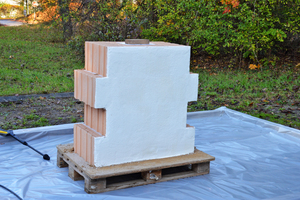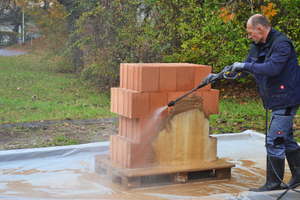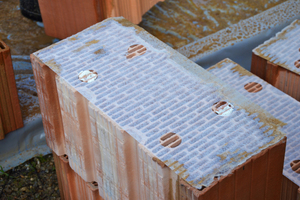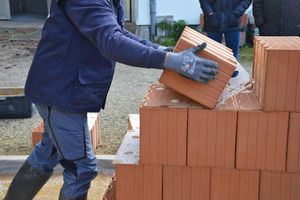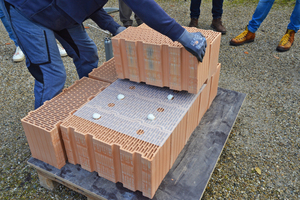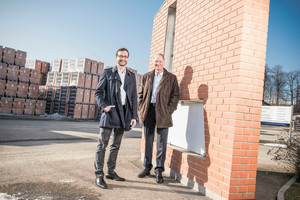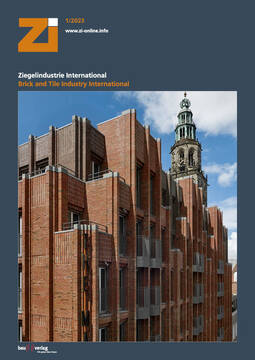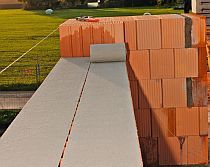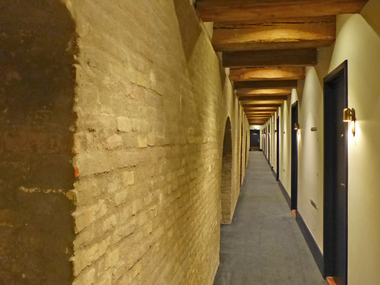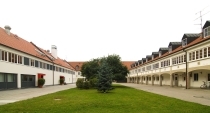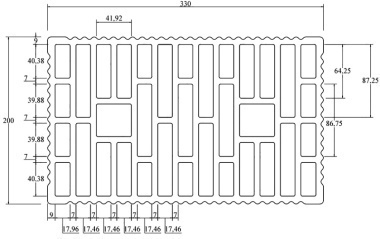Re-using bricks - Re-use instead of recycling
The main condition and obstacle for the recyclability of bricks is the separation of construction waste by type. In particular, mortars and plasters that adhere strongly to the bricks pose a problem. Bauhütte Leitl-Werke GmbH from Eferding in Austria has now developed a system for non-destructively degradable brickwork with flat-cut bricks. After a successful pilot project, the patent application is currently being examined by the authorities. The next step is to determine the technical limits of the approach.
Contradiction as the motor of development
At the beginning of the development, as Martin Leitl, until 2017 managing director and today consultant of the family-owned company founded in 1895, explains in conversation, was a contradiction. The lifespan of a building is usually estimated at 50, 80 or, if the worst comes to the worst, 100 years. The lifespan of bricks and masonry is much longer, as still usable brick buildings from the Middle Ages and bricks from antiquity prove.
Reuse of bricks as common practice
The reuse of bricks, on the other hand, is an old building technique. According to Martin Leitl, a more recent example of this can be found in post-war Vienna. Bricks from destroyed houses were collected, mortar and plaster residues adhering to them were knocked off and the bricks were reused in the construction of houses. In today‘s Vienna, many buildings can be found that were built with reused bricks.
Conditions and challenges of deconstruction
This was possible because the mortars and plasters used at that time consisted mainly of lime and did not adhere much to the small-format bricks that were common at the time. Today, cement mortars and plasters and large-format bricks are mostly used. These were developed to improve masonry properties such as load-bearing capacity, sound insulation and thermal insulation. Deconstruction and reuse were not considered.
Current building standards encourage the use of highly cementitious mortars and plasters by prescribing the same means to meet different structural requirements. For example, the same mortar is specified for the construction of a one-storey and a five-storey house, despite considerable differences. As a result, the mortar is designed for the highest load and for the most intensive bond.
The two functions of mortar in masonry
Leitl‘s approach was to question these specifications. Mortar fulfils two functions in masonry. Firstly, it ensures a firm bond and increases the load-bearing capacity and compressive strength of the masonry. Secondly, it levels out unevenness on brick surfaces, which usually occurs when bricks are cut. Both functions, says Martin Leitl, can be fulfilled without intensive adhesive mortar. Appropriate ballast in the masonry provides frictional connections between the bricks so that they cannot shift. Nowadays, the unevenness of modern plane bricks is only a few tenths of a millimetre.
Successful pilot test
On the basis of these two functions, Leitl has developed its tile bonding system consisting of a special adhesive applied at specific points and a fleece to compensate for the slight unevenness. The fleece also has a modulus of elasticity that is higher than the brick‘s transverse strain modulus. This reduces transverse tensile stresses that reduce the compressive strength of the masonry.
In an initial pilot test on building and masonry components under laboratory conditions, the bond has proven itself. The compressive strength of the adhesive and fleece is sufficient for common brick buildings. However, the connections can be loosened again with little effort and without damaging the bricks. A corresponding patent has been applied for and is currently (as of January 2023) still being examined.
Trials with clay plaster
Leitl is also investigating degradable plasters. For this purpose, walls with areas of 1.5 square metres were connected without mortar, covered with clay plasters of various types from the project partner Claytec and then removed again. Currently, further investigations are underway with separable plasters in the outdoor area, as common clay plasters require protection from weathering such as roof overhangs or other cladding.
Second project started - How high to get with adhesive and fleece
In a further step, the application possibilities and serviceability of the new joint are currently being determined. For this purpose, it must be clarified which tensile, shear and pressure loads masonry connected in this way can withstand and up to which building dimensions its use is possible. For this second phase of the project, which started last year, they are working together with structural engineering institutes, says Martin Leitl.
Leitl‘s goal is to fulfil the requirements for the structural approval of the connection system with the tests. The tests will run until mid-2023. Depending on the results, a follow-up project is planned for separable masonry connections from other building components.
Future business model of the brick industry lies in reuse
But if the brick re-use system is successful, won‘t Leitl be taking the axe to its own business as a brick manufacturer? Martin Leitl denies this. In view of the finite reserves in the clay pits, which may last for another 100 years, one has to pursue resource-saving approaches anyway. In addition, reused bricks make a lot of sense from an ecological point of view. If a brick can be used not only for 80 years, but for 1000 years, for example, the grey energy bound up in it and the corresponding CO2 emissions approach zero in life-cycle considerations. The business model of the brick industry, says Martin Leitl, will have to adapt to the requirements of the circular economy, turing away from the production of new bricks to the reuse of existing bricks.
Open for cooperation partners
According to Leitl, in addition to the brick reuse system, the entire building should consist of reusable components in the future, if possible. For this goal, Leitl is looking for cooperation partners for further research and development, as they themselves cannot cover all building materials and components. Industry companies are expressly invited to push this development further.

